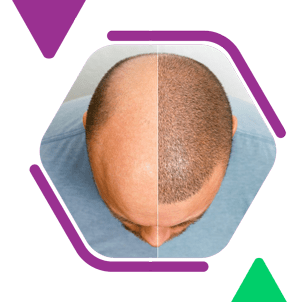Surgical Treatment

Surgical Treatment-Hair Restoration
Hair transplant is another treatment option for MPB & FPB. Hair follicles are taken from occipital scalp and transplanted in bald area.
Hair restoration through surgical methods, particularly hair transplants, has emerged as a popular and effective solution for individuals experiencing Male Pattern Baldness (MPB) and Female Pattern Baldness (FPB). While the loss of hair can deeply affect one’s self-esteem and confidence, advancements in medical technology have paved the way for restoring natural hairlines and regaining lost hair through surgical interventions.
The process of hair transplantation involves meticulous surgical techniques aimed at relocating healthy hair follicles from a donor site, typically the occipital scalp, to the recipient bald areas on the scalp. This procedure is meticulously planned and executed to achieve natural-looking results that seamlessly blend with the existing hair.
The first step in the hair transplant process involves consultation with a qualified and experienced hair restoration surgeon. During this initial assessment, the surgeon evaluates the patient’s hair loss pattern, scalp condition, and overall health to determine candidacy for hair transplantation. Factors such as the extent of hair loss, hair quality, and the patient’s expectations are carefully considered to develop a personalized treatment plan.
Once deemed suitable for the procedure, the patient undergoes pre-operative preparations, which may include blood tests, scalp examination, and medical history review to ensure safety and optimal outcomes. Additionally, patients are provided with detailed instructions on pre-operative care, which may involve avoiding certain medications or lifestyle habits that could interfere with the surgery.
On the day of the procedure, the patient is prepared for surgery, which is typically performed under local anesthesia to minimize discomfort. The surgical team begins by harvesting hair follicles from the donor site, often the back or sides of the scalp, where hair is genetically programmed to resist balding. This donor area is selected for its abundant hair follicles and the suitability of the hair for transplantation.
The extraction of hair follicles can be performed using various techniques, including Follicular Unit Transplantation (FUT) or Follicular Unit Extraction (FUE). In FUT, a strip of scalp containing hair follicles is surgically removed from the donor site, and the incision is meticulously closed with sutures. This method allows for the extraction of a larger number of grafts in a single session, making it suitable for patients requiring extensive hair restoration.
On the other hand, FUE involves the extraction of individual hair follicles directly from the donor area using a specialized punch device. This minimally invasive approach leaves tiny circular scars that are virtually undetectable, making it a preferred option for patients concerned about scarring and prefer shorter recovery times.
Once the hair follicles are harvested, they are meticulously prepared under a microscope by skilled technicians to ensure their viability and integrity. The recipient site, where the balding or thinning areas exist, is then prepared by creating tiny incisions or recipient sites with precision instruments. The angle, depth, and density of these incisions are crucial to achieving natural-looking results and optimal hair growth.
The prepared follicular units are then carefully implanted into the recipient sites, following the natural hair growth pattern to achieve a seamless integration with the existing hair. The placement of grafts requires precision and artistry to ensure a harmonious distribution of hair that complements the patient’s facial features and aesthetic goals.
Throughout the procedure, the surgical team maintains a sterile environment and adheres to strict protocols to minimize the risk of infection and complications. Patients are closely monitored during the surgery, and any discomfort or concerns are promptly addressed to ensure a positive experience.
Following the completion of the transplant procedure, patients are provided with post-operative instructions and medications to facilitate healing and promote optimal graft survival. It is normal to experience some swelling, redness, and minor discomfort in the days following surgery, which gradually subsides as the scalp heals.
The transplanted hair initially sheds within a few weeks of the procedure, which is a natural part of the hair growth cycle. However, the dormant hair follicles remain beneath the surface and gradually begin to regrow new hair over the coming months. Patients typically start to notice visible improvements in hair density and coverage within three to six months, with continued growth and thickening over the following months.
As the transplanted hair continues to grow, it blends seamlessly with the existing hair, creating a fuller and more natural-looking appearance. With proper care and maintenance, the results of hair transplantation can be long-lasting and transformative, restoring not only the patient’s hair but also their confidence and self-esteem.
In addition to hair transplantation, complementary treatments such as platelet-rich plasma (PRP) therapy and low-level laser therapy (LLLT) may be recommended to enhance hair growth and improve the overall health of the scalp. These non-invasive procedures can be performed in conjunction with hair transplantation or as standalone treatments to optimize results and promote hair regrowth.
In conclusion, hair transplantation offers a viable solution for individuals seeking to address hair loss and restore a full head of hair. With advancements in surgical techniques and technology, patients can achieve natural-looking results that enhance their appearance and quality of life. By consulting with a qualified hair restoration surgeon and undergoing a personalized treatment plan, individuals can regain their confidence and enjoy the lasting benefits of a full head of hair.
Our Services
- Hair Loss
- Causes of Hair Loss
- Clinical Features
- Laboratory Test
- Medical Treatment
- Cyclic Treatment
- PRP
- Hair Transplant
- Surgical Treatment
- FUE
- FUT
- Beard Reconstruction
- Moustache Reconstruction
- Eyebrow Reconstruction
- Side Burn Reconstruction
- Complications of Hair Transplant
- Alopecia Areata
- Telogen Effluvium
- Laser Treatment



 Book an Appointment
Book an Appointment